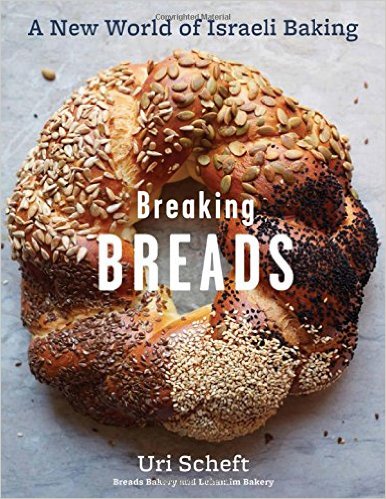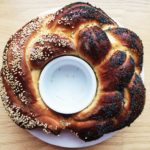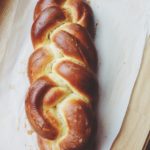A Bread Baking Adventure
By Sydney Manning
Like Oprah, I love bread. I would eat it all day, every day if the end result wouldn’t be me documented on an episode of My 600-lb Life. Bread and I have a somewhat complicated relationship. As much as I love it, I have never been able to bake it without a hitch. Sometimes it’s over-proofed. Sometimes it’s under-proofed. And sometimes it’s shoved into a screaming-hot oven at 3:00 a.m. because I’ve had enough, and also can’t believe that I’ve been bested once again by a giant blob of dough that I’ve tried (and failed) to style into an intricate design. But I always keep trying. For New Year’s this year, I stayed in, struggling through a chocolate challah recipe that I got out of an old issue of Bon Appetit. Since I was totally snowed in this weekend, I decided to make not one, not two, but three loaves of bread because I like to push myself, and (apparently) I like getting no sleep.

Have you heard about Uri Scheft’s cookbook, Breaking Breads? It came out in October and I absolutely love it. It’s incredibly detailed, beautifully photographed, and packed with tons of recipes for breads and for dishes like Algerian salad and Babaghanouj. I decided to try Uri’s version of challah to see how it would compare to other challah loaves I’ve made in the past. I started out by whisking two packets of active dry yeast into 1 2/3 cups of cool, room-temperature water in the bowl of a stand mixer with the dough hook attached. Next, I added seven cups of unbleached all-purpose flour, a tablespoon of fine salt, and five tablespoons of canola oil. I set the mixer to medium speed for one minute, scraping down the sides or pushing the dough down when it occasionally climbed up the hook. After about three minutes, I turned the dough out onto a lightly floured surface and pushed and tore it, folding it onto itself, then giving it a quick quarter turn before repeating the motion. I did this for two minutes, then rolled the dough around and around until it had become a smooth ball that was easily the size of a human head. I put the dough ball into a large, floured bowl, covered it in cling film, and set it aside in a warm place to rise for what I prayed would be 40 minutes, but knew in my heart of hearts would be longer.
Sure enough, nearly two hours (and two episodes of Chopped) later, I came into the kitchen to find that my dough had risen so much that it was very close to spilling out of the top. Had I left it to proof for too long? Probably, but there was no turning back. Carefully, I peeled it out of the bowl, making sure not to release any of the vital gasses that I had spent two hours of my life waiting to puff up the dough. I flattened the ball into a rectangle using my palms, then using a sharp bench knife, cut the dough into three pieces. I cut those three pieces into three more pieces each, totaling nine equal-ish sized pieces (perhaps it would’ve been wise to use my ruler, but who had time to find one?). I took a piece, flattened it into a rectangle, then folded the top towards me, and flattened it again. I did this three more times until I ended up with a cylinder. I repeated the process with the remaining eight pieces. Once I had nine cylinders, I rolled each into 14-inch (give or take) ropes, pinched at the ends. My ropes may have been all different lengths, but they were ropes nonetheless and I was soldiering on; the time had come for me to start braiding. I braided the first two loaves in the traditional way and placed them on parchment-lined baking sheets. As I got to the third, I decided to mix things up a bit. Once I had braided the third loaf and pinched the ends, as I had done with the first two, I curved the top end of the loaf around to meet the bottom, creating a beautiful braided circle. In the
Once I had nine cylinders, I rolled each into 14-inch (give or take) ropes, pinched at the ends. My ropes may have been all different lengths, but they were ropes nonetheless and I was soldiering on; the time had come for me to start braiding. I braided the first two loaves in the traditional way and placed them on parchment-lined baking sheets. As I got to the third, I decided to mix things up a bit. Once I had braided the third loaf and pinched the ends, as I had done with the first two, I curved the top end of the loaf around to meet the bottom, creating a beautiful braided circle. In the middle I placed an oval ramekin so that the loaf would maintain its shape while baking. The ramekin would also make a great holder for the dipping honey later on. Next I put one large egg, a tablespoon of water, and a pinch of fine salt into a bowl and began whisking. This was my egg wash. Very lightly, I painted the wash onto the loaf, making sure that every inch had a sheen. On one half of the loaf I sprinkled a generous amount of poppy seeds, spreading them out with my finger when I noticed clumps. On the other half, I sprinkled white sesame seeds. I placed clean kitchen towels over the two traditional loaves, then left all three to rise for 60 minutes.
When my loaves had sufficiently risen (or I just grew impatient, I can’t be sure), I placed racks on the top and bottom thirds of the oven and preheated it to 425 degrees Fahrenheit. I brushed the remaining loaves with the egg wash, and baked each loaf for 25 minutes, rotating the baking sheets from top to bottom and front to back at the 15-minute mark. Finally, nearly seven long hours later, I had three unevenly-sized but no less beautiful (to me) loaves of challah cooling on the counter. As warm and wonderful-smelling as each loaf was, I have a very strict “no eating after midnight” policy, and it was well past that cut-off. It wasn’t until the next afternoon that I was finally able to taste the breads. The loaves sat uncovered overnight, so the first order of business was to wrap my two traditional loaves in two layers of cling film, then a layer of aluminum foil for good measure. They were on their way to the freezer for safe-keeping. It was the circle loaf that I was after.
Bread is best eaten slightly warm, so I placed the circle loaf in a 350-degree oven for 10 minutes, just to give it a little jolt of life. Once it was out, I placed the whole thing, sheet pan and all, on the table and grabbed the honey (I’d made a point to get the “good” honey at the market.) I cut off a generous piece for myself, really sunk it into the honey (I had to get my money’s worth), and took a bite. Good, I thought, but not great. Perhaps I would try again, but this time without the honey. Again, good, but not great. There was something different about this challah. For starters, it wasn’t as sweet as challahs that I had made in the past. And it lacked that signature pillowy-ness. Where had I gone wrong? Should I have left the dough to rise for a shorter amount of time? Maybe I should’ve left the ropes a little looser when I braided them. The bread just seemed a little…dull. But, all was not lost. I still had two other loaves in the freezer just begging to become french toast one day. The cure for dull bread is frying it in butter and drenching it in Vermont maple syrup.
Thinking back, would I make Uri’s version of challah again? Yes. Next time, I’ll shorten the proofing time. I’ll add a little bit more sugar. Perhaps I will even give it a filling like Nutella, or cinnamon and brown sugar. No matter what happens, bread never disappoints when there’s filling in the middle.

